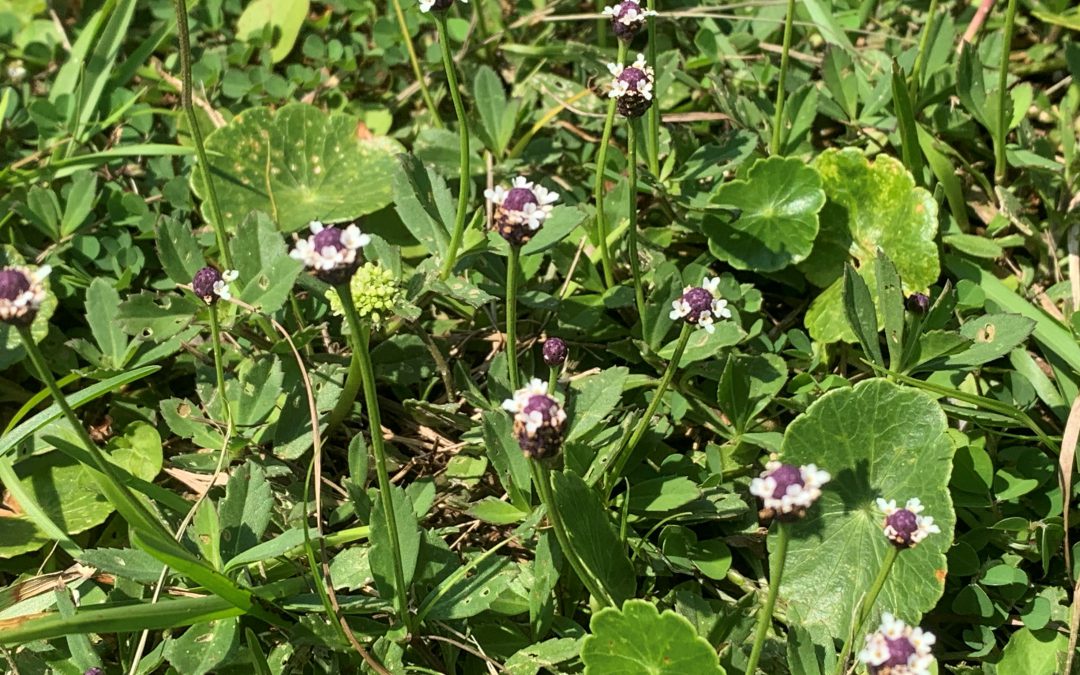
Frogfruit as a Turf Companion
Homeowners may consider growing Frogfruit, Phyla nodiflora as a companion plant in turf areas. Learn the qualities of this groundcover with UF IFAS Extension Escambia County.

Homeowners may consider growing Frogfruit, Phyla nodiflora as a companion plant in turf areas. Learn the qualities of this groundcover with UF IFAS Extension Escambia County.
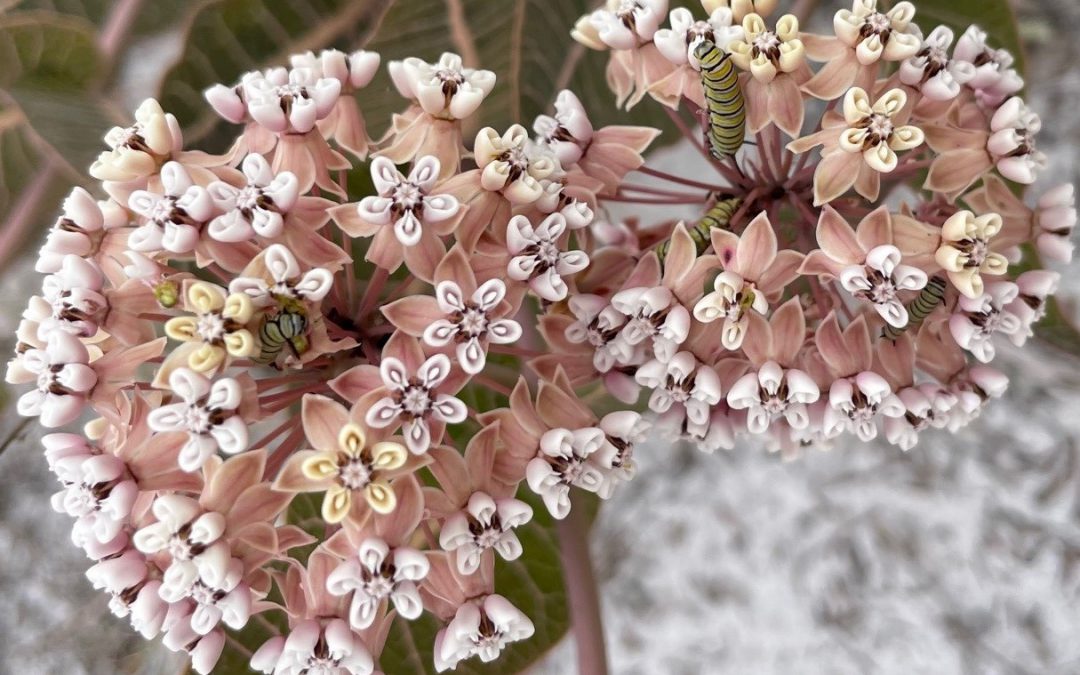
Like finding buried treasure on a desert island, walking up on a mound of sandhill milkweed (Asclepias humistrata) may elicit cries of excitement from someone who understands what they’re seeing. And not unlike searching for pirate booty, there’s a bit of danger involved, too—milkweed is highly toxic.
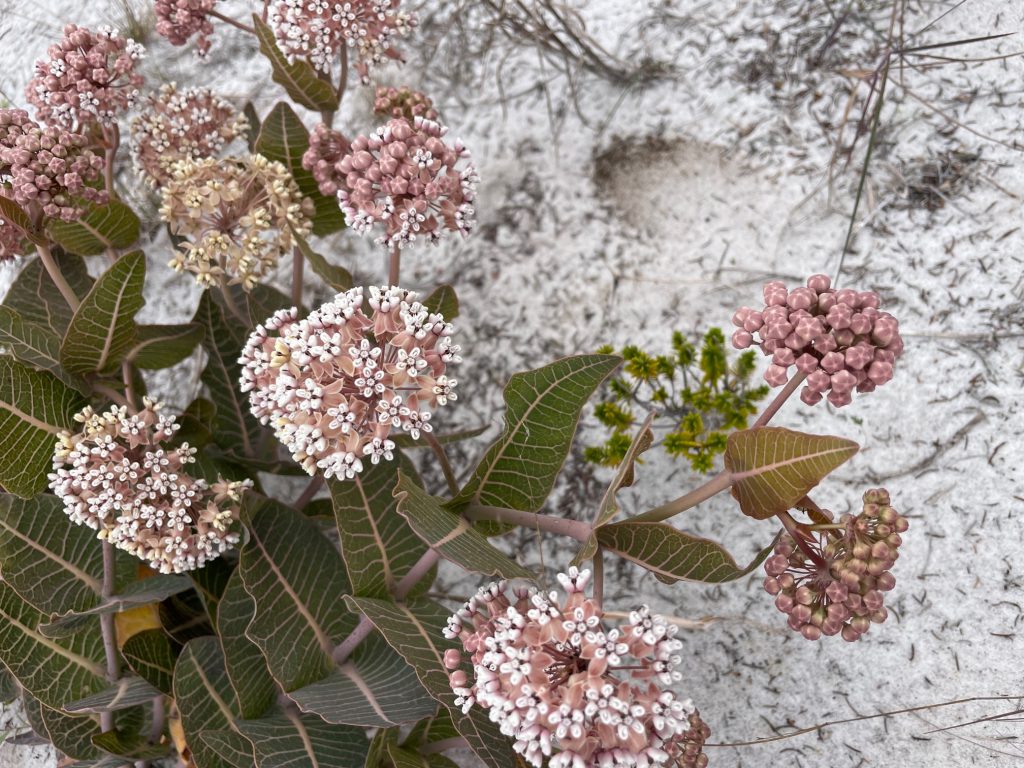
Last month in the dunes of Perdido Key, our Master Naturalist class found robust clusters of eye-catching, pink-tinged leaves, blooms, and buds of sandhill milkweed. Also known as pinewoods milkweed, this variety thrives in dry, sandy soils. It is native to the southeast, found typically in the wilds of Alabama, Mississippi, Louisiana, Georgia, Florida, South Carolina, and North Carolina. Its genus name, “Asclepias” refers to the Greek god of healing—indigenous people have used the plant for medicinal purposes (dysentery treatment and wart removal, in particular) for centuries. The species name humistrata means “spreading,” which describes the growth habit of the plant. Milkweed is highly toxic, so we do not recommend trying any medicinal uses at home! The “milk” part of the common name refers to its sap, which is a thick, sticky, white substance containing that toxic chemical.
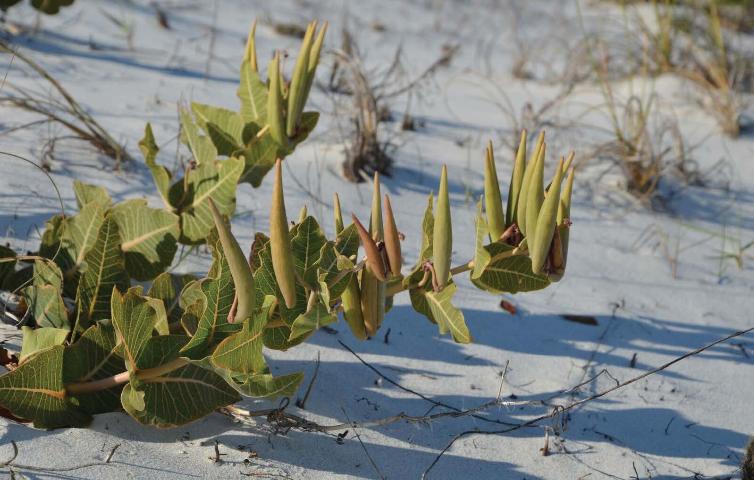
As the only food source for the monarch caterpillar, healthy milkweed plants are crucial for maintaining populations of the famous monarch butterfly. The plant itself is rather complex and beautiful. Its five-petaled blooms grow in tight clusters, on stalks sticking several inches off the ground. The leaves are broad and a deep forest green, edged in the pale maroon/pink of the stems and flowers. The seedpods of milkweed are quite large (3-6” long), resembling pea pods and full of seeds. Each seed has a wispy white fiber attached, which helps it disperse in the wind like a dandelion. The fibers have been used for years as stuffing for pillows and mattresses, and were used for life jackets during World War 2.
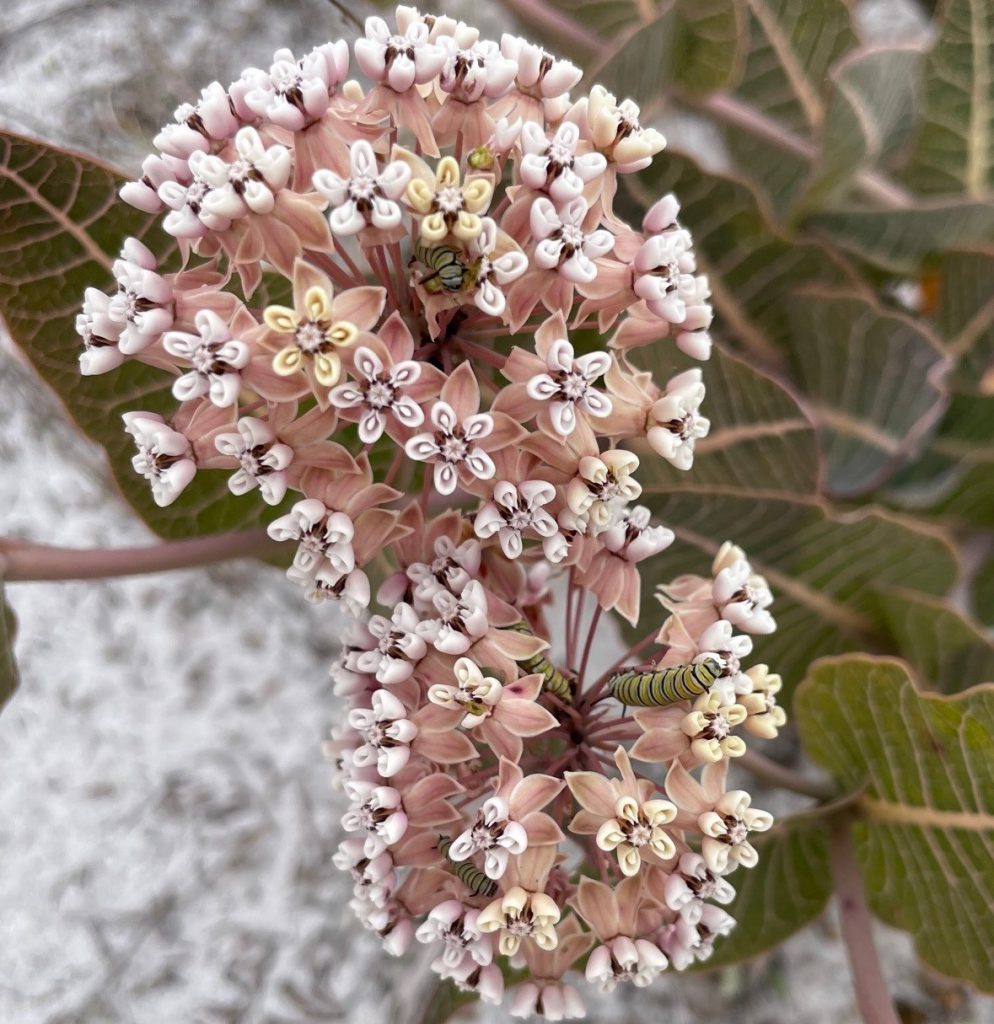
The first cluster of milkweed we found was host to multiple monarch caterpillars, recognizable by their greenish-yellow, white, and black stripes. By the time you see caterpillars, the milkweed is already working its magic, transferring its toxins to the insects but causing them no harm. Monarchs have evolved the capability to digest and metabolize this poison, which would induce heart attacks in nearly any vertebrate animal. Adult monarchs use several nectar sources, including milkweed flowers, and females lay their eggs on the plant so that their young can begin eating once hatched.
In the animal kingdom, red and orange are signs of danger. The bright orange coloration of an adult monarch butterfly serves as a warning to would-be predators to exhibit caution, as the toxins from their food sources stay within the butterfly’s body. The copycat viceroy, soldier, queen, and Gulf fritillary butterflies benefit from this trait by using mimicry in their own orange coloration to ward off predators.
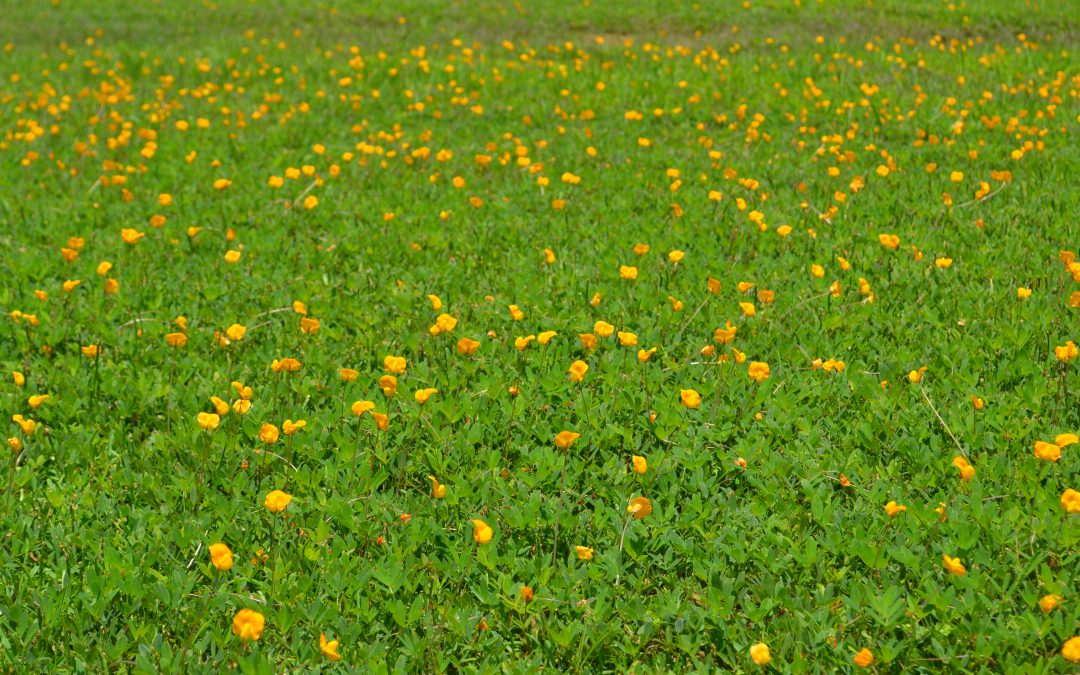
Turfgrass remains a popular groundcover for most home landscapes. Perennial peanut offers potential as a turfgrass companion in North Florida. Learn the pros and cons of using perennial peanut with existing turfgrass with UF IFAS Extension Escambia County.
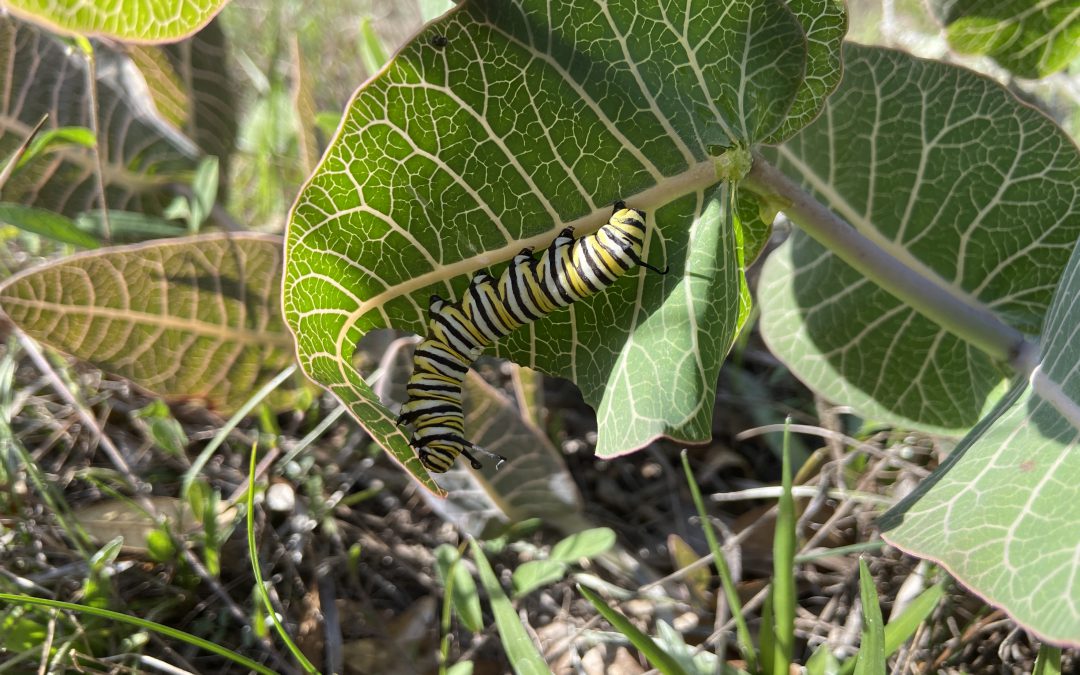
On August 12, 2021, our panel answered questions on a wide variety of landscape topics. Maybe you are asking the same questions, so read on!
Ideas on choosing plants
What are some perennials that can be planted this late in the summer but will still bloom through the cooler months into fall?
Duranta erecta ‘Sapphire Showers’ or ‘Gold Mound’, firespike, Senna bicapsularis, shrimp plant, lion’s ear
Where can native plants be obtained?
Gardening Solutions: Florida Native Plants – see link to FANN: https://gardeningsolutions.ifas.ufl.edu/plants/ornamentals/native-plants.html
What are some evergreen groundcover options for our area?
Mondo grass, Japanese plum yew, shore juniper, ajuga, ferns such as autumn fern.
What are some ideas for partial morning sun butterfly attracting tall flowers to plant now?
Milkweed, salt and pepper plant, swamp sunflower, dune sunflower, ironweed, porterweed, and salt bush.
I’m interested in moving away from a monoculture lawn. What are some suggestions for alternatives?
Perennial peanut, powderpuff mimosa, and frogfruit.
We are new to Florida and have questions about everything in our landscape.
Florida-Friendly-Landscaping TM Program and FFL Web Apps: https://ffl.ifas.ufl.edu/
https://ffl.ifas.ufl.edu/resources/apps/
UF IFAS Gardening Solutions: https://gardeningsolutions.ifas.ufl.edu/
What are some of the top trends in landscaping today?
Houseplants, edible gardens, native plants, food forests, attracting wildlife, container gardening, and zoysiagrass lawns
Edibles
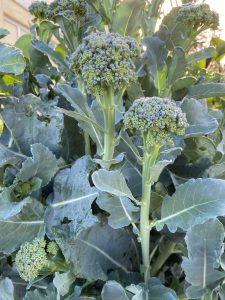
Artwork broccoli is a variety that produces small heads. Photo credit: Mary Salinas UF/IFAS Extension.
What vegetables are suitable for fall/winter gardening?
Cool Season Vegetables: https://gardeningsolutions.ifas.ufl.edu/plants/edibles/vegetables/cool-season-vegetables.html
North Florida Gardening Calendar: https://edis.ifas.ufl.edu/publication/EP451%20%20%20
Florida Vegetable Gardening Guide: https://edis.ifas.ufl.edu/publication/vh021
How can I add herbs to my landscape?
Herbs in the Florida Garden: https://gardeningsolutions.ifas.ufl.edu/plants/edibles/vegetables/herbs.html
My figs are green and hard. When do they ripen?
Why Won’t My Figs Ripen: https://www.lsuagcenter.com/profiles/rbogren/articles/page1597952870939
What is best soil for raised bed vegetable gardens?
Gardening in Raised Beds: https://edis.ifas.ufl.edu/publication/EP472
And there are always questions about weeds
How can I eradicate cogongrass?
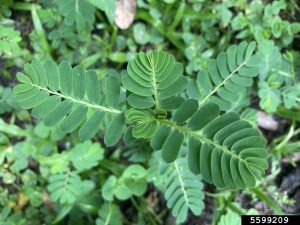
Chamber bitter is a troublesome warm season weed in our region. Photo credit: Brantlee Spakes Richter, University of Florida, Bugwood.org
Cogongrass: https://edis.ifas.ufl.edu/publication/WG202
Is it okay to use cardboard for weed control?
The Cardboard Controversy: https://gardenprofessors.com/the-cardboard-controversy/
What is the best way to control weeds in grass and landscape beds?
Weed Management Guide for Florida Lawns: https://edis.ifas.ufl.edu/publication/EP141
Improving Weed Control in Landscape Planting Beds: https://edis.ifas.ufl.edu/pdf/EP/EP52300.pdf
Landscape practices
Can ground water be brackish and stunt plants?
Reclaimed Water Use in the Landscape: https://edis.ifas.ufl.edu/publication/ss545
How can I prevent erosion from rainwater runoff?
Stormwater Runoff Control – NRCS: https://www.nrcs.usda.gov/wps/portal/nrcs/detail/national/water/?cid=nrcs144p2_027171
Rain Gardens: https://gardeningsolutions.ifas.ufl.edu/design/types-of-gardens/rain-gardens.html
And https://gardeningsolutions.ifas.ufl.edu/pdf/articles/rain-garden-manual-hillsborough.pdf
What is the best time of the year to propagate flowering trees in zone 8B?
Landscape Plant Propagation Information Page – UF/IFAS Env. Hort: https://hort.ifas.ufl.edu/database/lppi/
Which type of mulch works best on slopes greater than 3 percent?
Landscape Mulches: How Quickly do they Settle?: https://edis.ifas.ufl.edu/publication/FR052
When should bulbs be fertilized?
Bulbs and More – UI Extension: https://web.extension.illinois.edu/bulbs/planting.cfm
Should I cut the spent blooms of agapanthus?
Agapanthus, extending the bloom time: https://gardeningsolutions.ifas.ufl.edu/plants/ornamentals/agapanthus.html
http://blogs.ifas.ufl.edu/wakullaco/2020/10/07/extending-bloom-time/
Plant questions
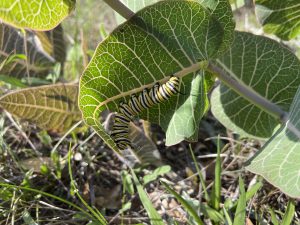
Monarch caterpillar munching on our native sandhill milkweed, Asclepias humistrata. Photo credit: Mary Salinas, UF IFAS Extension.
I planted native milkweed and have many monarch caterpillars. Should I protect them or leave them in nature?
It’s best to leave them in place. Featured Creatures: Monarch Butterfly: https://edis.ifas.ufl.edu/pdf/IN/IN780/IN780-Dxyup8sjiv.pdf
How does Vinca (periwinkle) do in direct sun? Will it make it through one of our panhandle summers? Can I plant in late August?
Periwinkles and No more fail with Cora series: https://gardeningsolutions.ifas.ufl.edu/plants/ornamentals/periwinkles.html#:~:text=Plant%20your%20periwinkles%20where%20they,rot%20if%20irrigated%20too%20frequently.
Insect and disease pests
What to do if you get termites in your raised bed?
The Facts About Termites and Mulch: https://edis.ifas.ufl.edu/publication/IN651
How to combat fungus?
Guidelines for ID and Management of Plant Disease Problems: https://edis.ifas.ufl.edu/publication/mg442
Are there preventative measures to prevent diseases when the humidity is very high and it is hot?
Fungi in Your Landscape by Maxine Hunter: http://blogs.ifas.ufl.edu/marionco/2020/01/16/fungi-in-your-landscape/
If you missed an episode, check out our playlist on YouTube https://www.youtube.com/watch?v=bp0HfdEkIQw&list=PLhgoAzWbtRXImdFE8Jdt0jsAOd-XldNCd
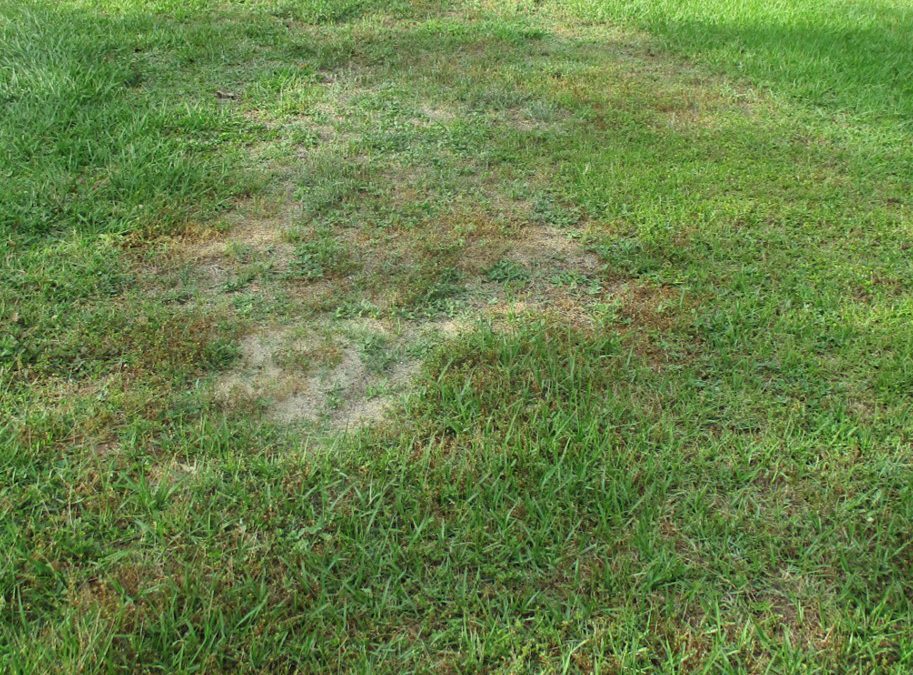
I’ll be the first to admit that North Florida lawns are frustrating. With time, most people discover this.
Why are lawns so difficult here? The answer involves a combination of factors.
We are not far enough north to benefit from the better soils. Florida is known for sandy, low fertility, low water holding capacity soils. Some areas of the country enjoy richer soils with better water and nutrient holding capacities. These better soils result in a more favorable lawn root environment with roots being more competitive and resilient.
Something else happens in more northern areas. The heavier soils and colder temperatures (sometimes resulting in the soil freezing) are natural means of inhibiting and/or controlling certain soil dwelling pests. For example, nematodes are not nearly the concern in northern lawns. Many people that move to our area have never heard of these microscopic roundworms that play havoc in our low fertility, warm, sandy soils. After a lawn has been in place for a number of years, allowing the nematode population to reach a threshold, the lawn begins to decline. And we have few legal, effective chemical control options for nematodes in Florida lawns.
Some other soil dwelling pests that northerners don’t have to deal with include ground pearls, small scale-like insects that bother centipedegrass roots. Mole crickets are not a pest much north of Central Alabama. Years ago, a representative with the company that manufactured the once popular mole cricket insecticide Oftanol told me that in the absence of the state of Florida, they would not sell enough Oftanol to keep it on the market. Take-all Root Rot, a common soil dwelling fungus, plays havoc in our Florida lawns and it is difficult to control.
We are not far enough north to use the more trouble-free northern grasses to create a permanent lawn. These include bluegrasses, fescues and perennial ryegrass. At best, these grasses can be used to overseed our lawns during the cooler fall and winter months to create a temporary winter lawn. But they will not survive our hot, wet summers.
We are not far enough south to benefit from the lack of freezing temperatures during winter. A late freeze that occurred on April 8 a number of years ago resulted in much lawn injury. I saw lawns with seventy percent kill from this late freeze. This is something that typically does not happen in Central and South Florida.
We deal with saltwater issues, high humidity, hurricanes and tropical storms, an array of lawn insects and diseases and extremes in rainfall and temperatures.
It’s no wonder most people become dissatisfied with their lawns. Perhaps we should lower our expectations and enjoy the natural flora and fauna of our state.